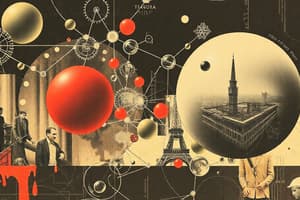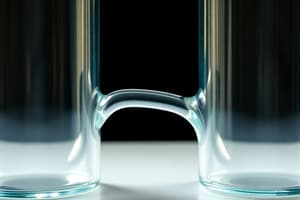Podcast
Questions and Answers
Which of the following describes the relationship between pressure and volume in Boyle's Law, assuming constant temperature?
Which of the following describes the relationship between pressure and volume in Boyle's Law, assuming constant temperature?
- No relationship
- Exponentially proportional
- Inversely proportional (correct)
- Directly proportional
Absolute temperature is measured in Celsius.
Absolute temperature is measured in Celsius.
False (B)
What is the formula for Charles' Law?
What is the formula for Charles' Law?
$V_1/T_1 = V_2/T_2$
According to Gay-Lussac's Law, if the temperature of a gas increases at constant volume, the ______ will also increase.
According to Gay-Lussac's Law, if the temperature of a gas increases at constant volume, the ______ will also increase.
Match the gas law with the variables it relates:
Match the gas law with the variables it relates:
Which of the following is the formula for converting Celsius to Kelvin?
Which of the following is the formula for converting Celsius to Kelvin?
Gauge pressure is the total pressure, including atmospheric pressure.
Gauge pressure is the total pressure, including atmospheric pressure.
Write the formula representing the combined gas law.
Write the formula representing the combined gas law.
Which of the following statements accurately describes Charles' Law?
Which of the following statements accurately describes Charles' Law?
According to Boyle's Law, if the volume of a gas decreases, the pressure will also decrease, assuming the temperature remains constant.
According to Boyle's Law, if the volume of a gas decreases, the pressure will also decrease, assuming the temperature remains constant.
What is the first step to take when using any of the gas law formulas that involve temperature?
What is the first step to take when using any of the gas law formulas that involve temperature?
According to Gay-Lussac's Law, if the temperature of a gas increases, the ______ will also increase, assuming the volume remains constant.
According to Gay-Lussac's Law, if the temperature of a gas increases, the ______ will also increase, assuming the volume remains constant.
Match the gas law with its real-world application:
Match the gas law with its real-world application:
In a hot air balloon, what causes the balloon to rise?
In a hot air balloon, what causes the balloon to rise?
When ribs move outward, lung volume decreases; by Boyle’s Law, when volume increases, pressure increases, forcing air into the lungs.
When ribs move outward, lung volume decreases; by Boyle’s Law, when volume increases, pressure increases, forcing air into the lungs.
Why is it harder to drink from a straw in deep water?
Why is it harder to drink from a straw in deep water?
According to the Kinetic Molecular Theory, warmer air molecules move ______ than colder air molecules, causing diffusion to happen faster.
According to the Kinetic Molecular Theory, warmer air molecules move ______ than colder air molecules, causing diffusion to happen faster.
What preventative measure can be taken to prevent car tires from bursting in hot environments like Death Valley?
What preventative measure can be taken to prevent car tires from bursting in hot environments like Death Valley?
Flashcards
Gauge Pressure
Gauge Pressure
Pressure measured relative to atmospheric pressure.
Atmospheric Pressure
Atmospheric Pressure
The pressure exerted by the weight of the air in Earth's atmosphere.
Absolute Pressure
Absolute Pressure
Total pressure that includes atmospheric pressure.
Boyle’s Law
Boyle’s Law
Signup and view all the flashcards
Charles' Law
Charles' Law
Signup and view all the flashcards
Kinetic Molecular Theory
Kinetic Molecular Theory
Signup and view all the flashcards
Diffusion
Diffusion
Signup and view all the flashcards
Temperature Conversion
Temperature Conversion
Signup and view all the flashcards
Ideal Gas Law
Ideal Gas Law
Signup and view all the flashcards
Gay-Lussac's Law
Gay-Lussac's Law
Signup and view all the flashcards
Boyle's Law
Boyle's Law
Signup and view all the flashcards
Gas Behavior in Hot Air Balloons
Gas Behavior in Hot Air Balloons
Signup and view all the flashcards
Impact of Temperature on Breathing
Impact of Temperature on Breathing
Signup and view all the flashcards
Effect of Temperature on Car Tires
Effect of Temperature on Car Tires
Signup and view all the flashcards
Pressure Changes in Sealed Bags on Planes
Pressure Changes in Sealed Bags on Planes
Signup and view all the flashcards
Converting Celsius to Kelvin
Converting Celsius to Kelvin
Signup and view all the flashcards
Study Notes
Gas Laws Study Notes
- Key Concepts:
- Gauge Pressure: Pressure relative to atmospheric pressure.
- Atmospheric Pressure: Pressure exerted by air.
- Absolute Pressure: Total pressure (including atmospheric).
- Absolute Temperature: Temperature in Kelvin (K = °C + 273).
- Volume (V): Space occupied by a gas.
- Direct Proportionality: One variable increases, the other increases (e.g., Charles' Law).
- Inverse Proportionality: One variable increases, the other decreases (e.g., Boyle's Law).
- Kinetic Energy: Energy of motion; higher temperature = higher kinetic energy.
- Mass: Amount of matter.
- Speed: Rate of motion; higher temperature = faster-moving molecules.
- Gas: State of matter with no fixed shape or volume.
- Kinetic Molecular Theory: Describes gas behavior using particle motion.
- Diffusion: Spreading of gas particles from high to low concentration.
- Density of Gas: Mass per unit volume (d = m/V).
Gas Law Equations
- Boyle's Law (P1V1 = P2V2): Pressure and volume are inversely proportional at a constant temperature.
- Charles' Law (V1/T1 = V2/T2): Volume and temperature are directly proportional at a constant pressure.
- Gay-Lussac's Law (P1/T1 = P2/T2): Pressure and temperature are directly proportional at a constant volume.
- Combined Gas Law (P1V1/T1 = P2V2/T2): Relates pressure, volume, and temperature when all three change.
Temperature Conversion
- K = °C + 273
Problem-Solving Strategies
- Identify given values.
- Select the correct equation.
- Solve for the unknown.
- Convert temperatures to Kelvin.
- Pay attention to direct and inverse relationships.
Real-World Applications
- Hot Air Balloons: Heating air inside expands it, decreases density, and causes the balloon to rise. Cooling air contracts it, increasing density, and makes the balloon descend.
- Breathing: When rib cage expands lung volume increases. By Boyle's Law, decreasing pressure allows air to rush into the lungs.
- Wilson the Volleyball: Increased temperature causes expansion, while decreasing temperature causes contraction (Charles' Law).
- Car Tires: Hot temperatures increase tire pressure (potentially leading to blowouts). Prevent by checking pressure and avoiding overinflating in high heat.
- Sealed Bags of Chips on a Plane: Lower external pressure causes expansion due to Boyle's Law (increased volume).
- Drinking from a Straw: Deeper water means higher water pressure, making it harder to draw liquid through.
- Movie Theater Smell: Warmer air molecules diffuse faster (Kinetic Molecular Theory).
- Survivor's Guide for Car Tires (Death Valley example): Heat increases pressure which needs consideration.
Final Tips
- Memorize gas laws and recognize the constant variables.
- Convert temperatures to Kelvin before calculations.
- Understand direct and inverse relationships between variables.
- Practice step-by-step problem-solving.
- Relate concepts to everyday life for better understanding.
Studying That Suits You
Use AI to generate personalized quizzes and flashcards to suit your learning preferences.





